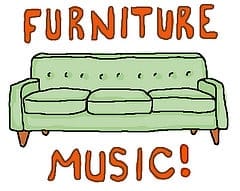Check this out: http://localcut.wweek.com/2009/01/13/furniture-music-2-cappella-romana/
Furniture Music #2: Cappella Romana
 A cappella music is probably as safe a place as any for me to start my year of classical immersion. We’ve all heard music like this—a precise, polyharmonic choir singing songs of devotion to God—in some form before. And as classical music goes, it is a style that goes down the easiest, at least to these ears. Even if you don’t understand the intricacies of the composition, you at least get the message in their lyrics.
A cappella music is probably as safe a place as any for me to start my year of classical immersion. We’ve all heard music like this—a precise, polyharmonic choir singing songs of devotion to God—in some form before. And as classical music goes, it is a style that goes down the easiest, at least to these ears. Even if you don’t understand the intricacies of the composition, you at least get the message in their lyrics.
So, why did I still feel so daunted when I went to see Cappella Romana recently? Blame the location: An ornate, 83-year-old Catholic church with spotless, gleaming marble floors, 40-foot high ceilings and walls covered in icons and carvings of a martyred Jesus. It would be hard for anyone who didn’t grow up in that denomination to simply ease into this rarefied environment.
This is par for the course for Cappella Romana, a chamber group that has been active for almost 20 years, and who spend most Sundays singing to the devout in churches like this all over the city. They are also active members of the larger musical community, performing in concerts around the country and releasing CDs like the one they were celebrating on this evening, Kontakion on the Nativity of Christ.
Richard Toensing composed this expansive work, using ancient Orthodox texts regarding the birth of Jesus and age-old methods of choral composition to create an expansive and rather haunting work regarding this familiar story. True, the holiday associated with this event had come and gone by the time this performance went down but it was a perfect fit for the Catholic calendar, as by early January, they are just reaching the end of the 12 Days of Christmas. Which helped explain for me the wreaths and red bows that the church was still festooned with.
Christian or not, you’d have to have ice water in your veins to not be moved in some way by CR’s performance. 26 members strong, the group put on a commanding show, wending their voices together into harmonies that ached one minute and roared the next. The power of this long piece was really in the solo sections, particularly Blake Applegate, Aaron Cain and David Stutz’s humble turn as the Magi and the sublime combination of Kari Ferguson and Mark Powell as the Christ child (a soprano and a tenor singing together to emphasize Jesus’ dual nature).
Besides the unique locale, one of the few aspects of this show that I was taken aback by was the sheer precision of the chorus’ vocals. I imagine this is a result of having spent the last few years on a strict diet of American Idol-style histrionics and the throat-shredding antics of any number of rock bands. To hear such clarity of tone and pitch was, frankly, a little chilling at times. It was hard to make myself believe that those sounds were really coming out of the voices of the people in front of me.
As well, if classical music is actually going to have another 50 years of relevance, chances are it will be thanks to groups like Cappella Romana. The majority of the performers were a lot younger than I was anticipating (the mean age had to be no older than 35). I don’t think there will ever be a shortage of people who want to sing (see my American Idol reference above or go to a karaoke bar some Saturday night) but I was happy to see some youthful voices keeping these traditional songs alive, if only for one more night.
Links:
Cappella Romana
Furniture Music Logo by Casey Jarman

You must be logged in to post a comment.